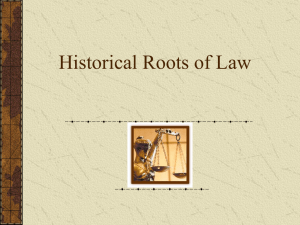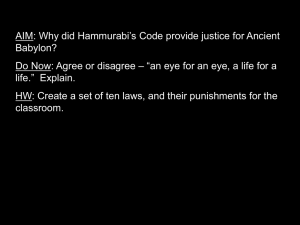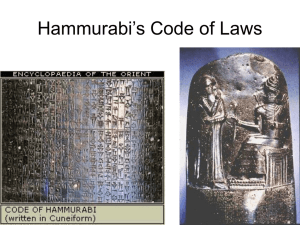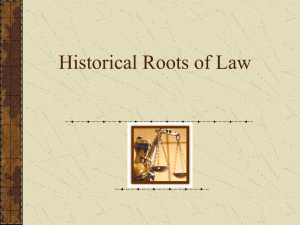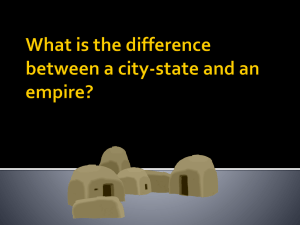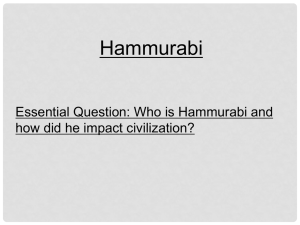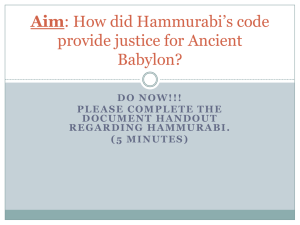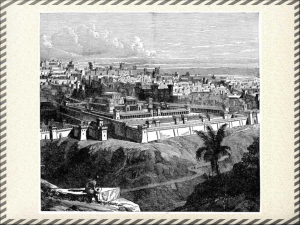6.2.4 - Hammurabi`s Code
advertisement
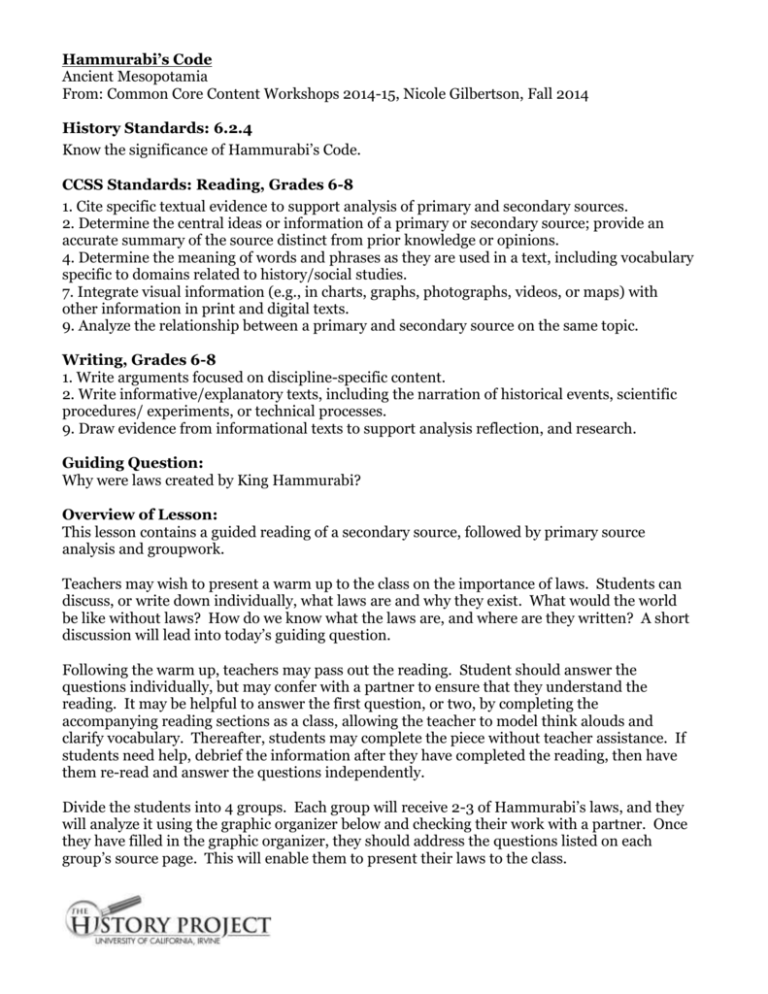
Hammurabi’s Code Ancient Mesopotamia From: Common Core Content Workshops 2014-15, Nicole Gilbertson, Fall 2014 History Standards: 6.2.4 Know the significance of Hammurabi’s Code. CCSS Standards: Reading, Grades 6-8 1. Cite specific textual evidence to support analysis of primary and secondary sources. 2. Determine the central ideas or information of a primary or secondary source; provide an accurate summary of the source distinct from prior knowledge or opinions. 4. Determine the meaning of words and phrases as they are used in a text, including vocabulary specific to domains related to history/social studies. 7. Integrate visual information (e.g., in charts, graphs, photographs, videos, or maps) with other information in print and digital texts. 9. Analyze the relationship between a primary and secondary source on the same topic. Writing, Grades 6-8 1. Write arguments focused on discipline-specific content. 2. Write informative/explanatory texts, including the narration of historical events, scientific procedures/ experiments, or technical processes. 9. Draw evidence from informational texts to support analysis reflection, and research. Guiding Question: Why were laws created by King Hammurabi? Overview of Lesson: This lesson contains a guided reading of a secondary source, followed by primary source analysis and groupwork. Teachers may wish to present a warm up to the class on the importance of laws. Students can discuss, or write down individually, what laws are and why they exist. What would the world be like without laws? How do we know what the laws are, and where are they written? A short discussion will lead into today’s guiding question. Following the warm up, teachers may pass out the reading. Student should answer the questions individually, but may confer with a partner to ensure that they understand the reading. It may be helpful to answer the first question, or two, by completing the accompanying reading sections as a class, allowing the teacher to model think alouds and clarify vocabulary. Thereafter, students may complete the piece without teacher assistance. If students need help, debrief the information after they have completed the reading, then have them re-read and answer the questions independently. Divide the students into 4 groups. Each group will receive 2-3 of Hammurabi’s laws, and they will analyze it using the graphic organizer below and checking their work with a partner. Once they have filled in the graphic organizer, they should address the questions listed on each group’s source page. This will enable them to present their laws to the class. During the last 10 minutes of class, have each group briefly present their laws, and have students take general notes. Ask the class as a whole what all of the laws had in common. For homework or as an exit ticket, have them answer the guiding question using complete sentences and specific details. Why were laws created by King Hammurabi? The Empire of Hammurabi After the destruction of Ur, many groups invaded Sumer. One of them, the Amorites, came from the deserts of Arabia. The Amorites took control of several Sumerian cities, including Babylon (bab uh lahn). At that time, Babylon was a small city of little importance. Under a king named Hammurabi, however, Babylon became the center of a new Mesopotamian empire. 1. Locate the route that the Amorites traveled from the deserts of Arabia to Babylon and trace it on the map. (Text from Ancient Civilizations, page 85) The Babylonian Empire Hammurabi became king of Babylon around 1792 B.C.E. For more than 30 years, he built up his army. Then he launched a series of all-out attacks against his rivals. Within a few years he had united Sumer and northern Mesopotamia into a new Babylonian (bab uh loh nee uhn) Empire. 2. What is an empire? If you need some help defining this term, look in your book (p.82). Don’t forget to use your own words to define the term. Read the section below and circle strategies that Hammurabi used to rule his empire. Use the reading to answer the questions. Hammurabi found new solutions to the problems of conquest. Rather than keep a large army around him as a sign of his power, Hammurabi spread his forces over his empire. This made it easier to feed his troops because they could obtain food locally. But he also kept careful written records of which troops went to each location. This allowed him to call his army together quickly when needed. 3. Why did Hammurabi have to keep his army organized? Hammurabi’s Law Code Hammurabi also tried to create a government strong enough to hold his empire together. He sent his own governors, tax collectors, and judges to distant cities. He issued one code of laws for all his people to follow. Some of his laws defined crimes and punishments. Others dealt with trade, marriage, adoption, daily wages, and the rights of landowners. There were even laws to protect patients and doctors. Hammurabi had his law code carved in stone for people to see. He wanted people to know the laws that they were to live by. In the introduction to his code, Hammurabi wrote that his aim was this: “to bring about the rule of righteousness in the land, to destroy the wicked and the evil-doers; so that the strong should not harm the weak— so that I should . . . further the well-being of mankind. —from Code of Hammurabi Hammurabi’s Code was important in two ways. First, it marked the first known attempt by a ruler to use laws to unite an empire. Later rulers would follow Hammurabi’s example. Second, his law code has provided historians with a great deal of information about life in Mesopotamia. 4. Why was Hammurabi’s Code of Laws important? 5. How did the laws help Hammurabi rule his empire? Primary Source Analysis: Today we will be doing the work of historians by reading and analyzing a primary source, Hammurabi’s Code. 1. 2. 3. 4. Get into pairs and read over the laws assigned to your group Fill out the chart below, with the information you have read about the laws. Answer the questions below the source to learn more about the importance of Hammurabi’s Code. Share your conclusions about source with the class. If a person committed a crime Then the person would be punished Explain how this law would keep Compare how this relates to order in a society today’s laws Group 1 Law 6: If a man has stolen goods from a temple, or house, he shall be put to death; and he that has received the stolen property from him shall be put to death Law 22: If a man has committed highway robbery and ahs been caught that man shall be put to death. Questions: 1. How do these laws compare with laws for stealing today? 2. Why do you think that the law punished both the person who stole the goods and the person who received the goods? 3. Why do you think the punishment for stealing was so severe? Group 2 Law 8: If a patrician has stolen ox, sheep, Donkey, pig, or goat, whether from a temple, or a house, he shall pay thirtyfold. If he be a plebian, he shall return tenfold. If the thief cannot pay, he shall be put to death. Law 15: If a man has induced either a male or female slave from the house of a patrician, or plebian, to leave the city, he shall be put to death. patrician—an upper class person thirtyfold—30 times the price plebian—a lower class person tenfold—10 times the price induced—to persuade someone to do something, to talk someone into something Questions: 1. How do these laws compare with laws for stealing today? 2. Why did the laws #8 have different punishments for different groups of people? Do our laws today give different punishments based on class? 3. What is the crime and punishment for law #15? Why do you think the punishment is so harsh? Group 3 Law 195: If a son has struck his father, his hands shall be cut off. Law 196: if a man has knocked out the eye of a patrician, his eye shall be knocked out. Law 198: if he has knocked out the eye of a plebian or has broken the limb of a patrician’s servant, he shall pay half his value. patrician—an upper class person plebian—a lower class person Questions: 1. How do these laws compare with laws for assault today? 2. What is the crime and punishment for law #195? Why do you think the punishment is so harsh? 3. Why did the laws #196 and 198 have different punishments for different groups of people? Do our laws today give different punishments based on class? Group 4 Law 229: if a builder has built a house for a man, and has not made his work sound, and the house he built has fallen, and caused the death of its owner, that builder shall be put to death. Law 237: If a man has hired a boat and a boatman, and loaded it with corn, wool, oil, or dates, or whatever it be, and the boatman has been careless, and sunk the boat, or lost what is in it, the boatman shall restore the boat which he sank, and whatever he lost That was in it. Questions: 1. How do these laws compare with laws for property today? 2. What is the crime and punishment for laws #229 ? Why do you think the punishment was so harsh? 3. After reading law 237, why do you think the law requires the boatman to pay back the owner of the goods? How does this compare with laws today? For example if you worked in a restaurant as a waiter and broke some dishes, would you have to pay back the owner for them? Why or why not?
